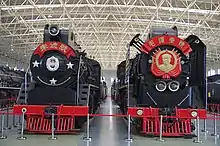China Railways JF
The China Railways JF (解放, Jiěfàng, "Liberation) class is a name given to a group of classes of steam locomotives for freight trains with 2-8-2 wheel arrangement operated by the China Railway. Originally designated ㄇㄎ壹 (MK1) class by the China Railways in 1951, the present name was assigned to them in 1959.[1]
| 解放 JF | |||||||||
|---|---|---|---|---|---|---|---|---|---|
 JF1 1861 - previously North China Transport ミカイ1861. | |||||||||
| |||||||||
| |||||||||
| Sources:[1][2] except where noted | |||||||||
Composition
.jpg.webp)
"New National Big Mika"type JF1-1299 (ex Manchukuo National ミカイ1299) at Harbin, 1984
The JF group of classes is made up of twenty different classes of 2-8-2 steam locomotives:
- JF1 - 2027 engines; 455 built new after 1950, rest inherited from South Manchuria Railway, Manchukuo National Railway, North China Transport, Central China Railway, and private railways;
- JF2 - 41 engines inherited from the South Manchuria Railway;
- JF3 - 150 engines built in Czechoslovakia and inherited from the Manchukuo National Railway;
- JF4 - 15 engines inherited from the South Manchuria Railway;
- JF5 - inherited from North China Transport, originally built for the Jichang Railway
- JF6 - around 475 engines; 5 built new after 1950, rest inherited from the South Manchuria Railway, the Manchukuo National Railway, and North China Transport;
- JF7 - originally built for the Jingfeng Railway, inherited from North China Transport;
- JF8 - originally built for the Huainan Railway, inherited from the Central China Railway;
- JF9 - 38 engines of the Sentetsu Mikasa class, inherited from the Central China Railway;
- JF10 - 30 engines, US Army Transportation Corps S200 class, given to China as postwar reconstruction aid from the UNRRA;
- JF11 - 70 engines inherited from the Central China Railway, originally built for the Jinpu Railway and the Zhegan Railway;
- JF12 - 46 engines inherited from North China Transport, originally built for the Jingsui Railway as Class 300;
- JF13 - inherited from North China Transport, built in Czechoslovakia in 1939;
- JF15 - 6 engines inherited from the Manchukuo National Railway, originally built for the Jihai Railway;
- JF16 - 18 engines inherited from Central China Railway and the Manchukuo National Railway;
- JF17 - inherited from North China Transport, originally built for the Jiaoji Railway;
- JF18 - around 14 engines inherited from South Manchuria Railway;
- JF21 - inherited from the Central China Railway, originally built for the Yuehan Railway.
- JF51 - inherited from the Yunnan-Vietnam Railway.
The locomotives were used across the Chinese railway system, and were in service on the national railway system until 1996; on industrial rail networks some locomotives remained in use until the early 2000s. Several of the class have been preserved.
Preservation

JF1-1191 and JF1-304 at the China Railway Museum
.jpg.webp)
JF2-2525 at Shenyang Railway Museum
.jpg.webp)
JF6-3022 at former Datong Railway Museum, 1999
JF1
- JF1-304, JF1-1191, JF1-2101, JF1-2121, JF1-4101: are preserved at the China Railway Museum.
- JF1-522: is preserved at Zhan Tianyou Park, Harbin.
- JF1-747: is preserved at Huainan Servicing Workshop, Hefei Locomotive Depot, Shanghai Railway Bureau.[3]
- JF1-886: is preserved at Hengdaohezi Locomotive Depot, Mudanjiang.
- ㄇㄎ1-1115: is preserved at Dandong Korean War Memorial Hall.
- JF1-1861: is preserved at Manzhouli.
- JF1-2023: is preserved at Linglong Park, Beijing
- JF1-2102: is preserved at CSR Sifang Co Ltd..
JF2
- JF2-2525: is preserved at Shenyang Railway Museum.
JF3
- JF3-2558: is preserved at Shenyang Railway Museum.
JF6
- JF6-3022: is preserved at the China Railway Museum.
- JF6-3329: is preserved at Shenyang Railway Museum.
JF9
- JF9-3673: is preserved at the China Railway Museum.
JF11
- JF11-3773: is preserved at the China Railway Museum.
- JF11-3787: is preserved at the China Railway Museum.
JF51
- JF51-738: is preserved at the China Railway Museum.
References
- 解放型蒸汽机车, www.zztl.com (in Chinese), archived from the original on 25 December 2008
- "JF1(ミカイ)形蒸気機関車", www.kuroganerail.jp (in Japanese), archived from the original on 2008-04-20, retrieved 2012-06-28
- 老吴主播, "淮南车间里的解放型蒸汽机车", Sina Weibo (in Chinese)
| Wikimedia Commons has media related to China Railways JF. |
This article is issued from Wikipedia. The text is licensed under Creative Commons - Attribution - Sharealike. Additional terms may apply for the media files.
